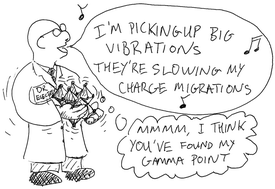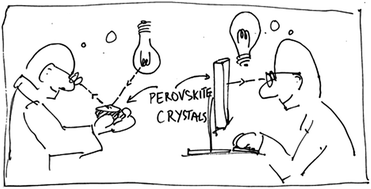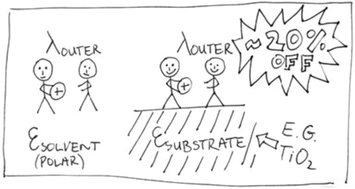Summary
I am interested in charge carrier behaviour in semiconducting materials and devices, particularly in solar cells and systems for energy conversion.
My group aims to understand and exploit charge transport, kinetic, and energy transfer phenomena to create devices with new material combinations and architectures for application in solar, sensing, and organic-inorganic electronics. Areas we are working on include:
- Measurement of energy loss mechanisms in alternative photovoltaic systems such as hybrid perovskite and dye sensitised solar cells
- Ionic charge transport and hysteresis in hybrid perovskite materials
- Development, application, and interpretation of transient optoelectronic measurements on devices
- Transport of charge within molecular monolayers
- Device simulation
- Stability and degradation in solution processed solar cells
- Optoelectronic probes of charging/discharging in battery materials
News
What happens to a semiconductor p-n junction (the foundation of diodes and many transistors) when the semiconductors contain mobile ionic defects? Phil Calado's comment in Nature Energy answers this question. In response to a paper claiming to create a metal halide perovskite p-n homojunction solar cell, we have shown how redistribution of mobile ions in the material would screen out the electric field normally present at the junction. The implication is that in mixed conducting (electronic and ionic) devices made with metal halide perovskites, diffusion, rather than drift, generally dominates electronic charge transport. This changes the design criteria for optimising perovskite devices.
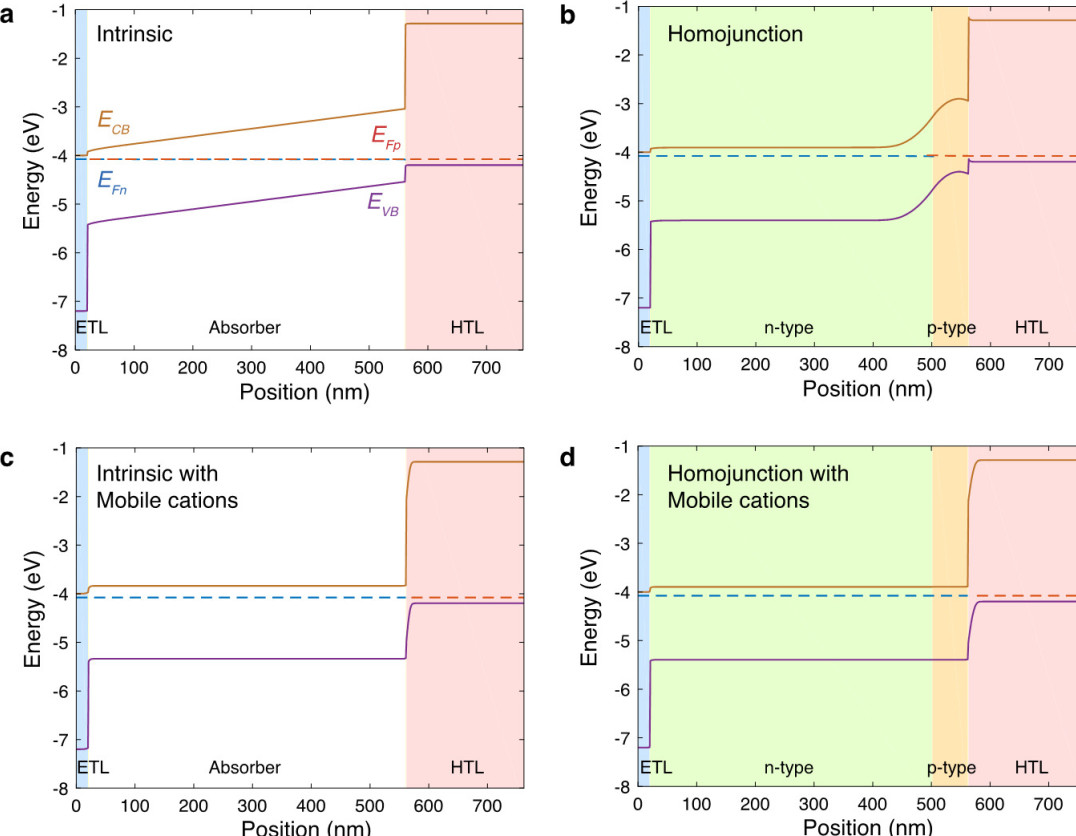
mobile ionic charge in the screens the electric field at the p-n homojunction
Circuit model of perovskite and mixed conducting devices finally published (after various editorial knock-backs and then four long review cycles since we uploaded to arXiv last May) in Energy & Environmental Science with the catchy title "Ionic-to-electronic current amplification in hybrid perovskite solar cells: ionically gated transistor-interface circuit model explains hysteresis and impedance of mixed conducting devices"! The model provides a fundamental framework for understanding the weird and wonderful behaviour of metal halide perovskite device physics. Through analysis of our Driftfusion device simulations we realised the charge transfer processes in the device can be described by coupling the electrostatic potential due to mobile ionic charge redistribution in the perovskite layer to the rate of interfacial charge transfer using bipolar transistor elements. This enables us to explain both the 'giant' capacitive and inductive behaviours seen in these devices. The simplest representation of the model is shown below where interfacial recombination of only one charge carrier species dominates device behaviour.
A more complete version of the model includes all the main interfacial processes:
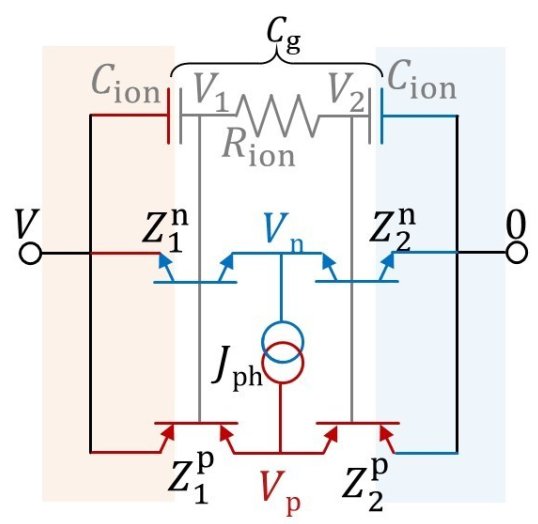
DRIFTFUSION: open source solar cell modelling code released on GitHub. DRIFTFUSION is a 1D time dependent drift diffusion code suitable for simulating solar cells, including those containing mobile ionic defects. Phil Calado the lead architect of the code highlighted the importance of the release "Now anyone can simulate their favourite anomalous optoelectronic behaviour in a solar cell, it's so easy even an exceptionally gifted child can do it!"
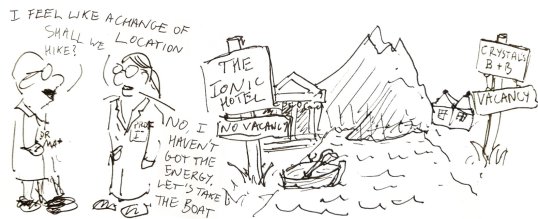
What's the influence of water intercalation or hydration of a hybrid perovskite crystal on the ease of ionic defect migration? Find out more in this article published in Journal of Material's Chemistry A from Chol-Jun Yu et al., Andrew McMahon and Aron Walsh.
Congratulations Aurelien for winning the Solid State Physics Thesis Prize. His weighty tome entitled 'Fundamental properties, disorder and stability of methylammonium lead halide perovskites for solar cells' follows on from Davide who won the same prize last year for his slightly lighter (in mass) thesis 'Intermolecular charge transport in dye monolayers'.
If the transport of ionic defects is responsible for hysteresis in perovskite solar cells, why is hysteresis removed or reduced by changing the contact materials? This question has puzzled the field since people started to dig into the underlying causes of hysteresis in this class of photovoltaic. Now we think we've figured it out. Phil and Andrew's study, published in Nature Communications shows that both ion migration and significant recombination at the contacts must be present in order to observe hysteresis in current-voltage measurements. We developed a set of optoelectronic measurements that enable us to infer how the ionic charge distribution in hybrid perovsktie solar cells changes as they are operated. We refer to these measurements, developed by the Perovskite Imperial Group, as 'transient of the transients' or PIG TROTTR for short. The TROTTR measurements involve repeatedly measuring the photovoltage response of a solar cell to short light pulses as its open circuit voltage evolves when the continuous background light is turned on. These measurements coupled with another new type of photocurrent transient measurement developed with my colleague Brian O'Regan in Berkeley (published in Energy & Environmental Science) indicate that ion migration occurs regardless of whether hysteresis is observed in the devices.
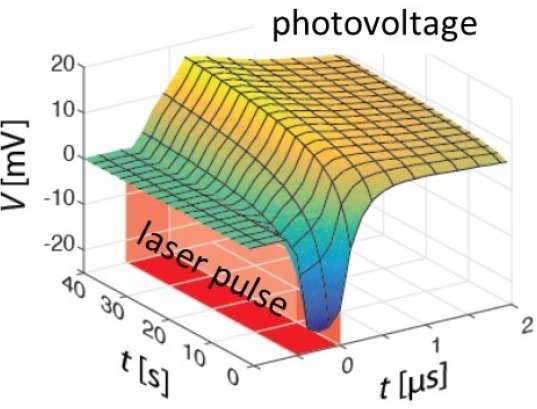
An example of a TROTTR measurement showing anomalous negative transient photovoltage deflections evolving with time after illumination with a bias light. The return of the transient to positive values corresponds to the relaxation of the ionic defects to a new distribution in the material.
There is a brief news story about the study on the college website.
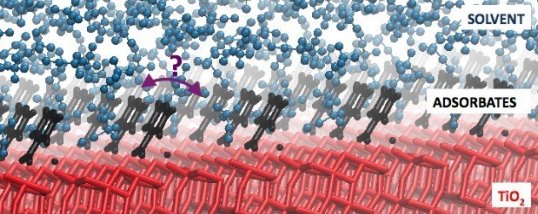 How mobile are dye adsorbates and acetonitrile molecules on the surface of TiO2 nanoparticles? The answer is relevant to charge conduction through molecular monolayers, molecular movements may help to shuttle charges through a monolayer. We set out to answer this question using quasi-elastic neutron scattering (QENS) - a technique where we measure the tiny changes in energy experienced by a beam of neutrons which are scattered by hydrogen atoms in a sample. The neutrons can gain or lose energy according to the movement of the atoms they scatter from. In our experiments we found that the molecules attached to the surface of TiO2 nanoparticles were immobile within the time resolution of the measurement - about 10 picoseconds through to a few nanoseconds. So any charge shuttling that may occur will be on longer timescales. The work is now published in Scientific Reports.
How mobile are dye adsorbates and acetonitrile molecules on the surface of TiO2 nanoparticles? The answer is relevant to charge conduction through molecular monolayers, molecular movements may help to shuttle charges through a monolayer. We set out to answer this question using quasi-elastic neutron scattering (QENS) - a technique where we measure the tiny changes in energy experienced by a beam of neutrons which are scattered by hydrogen atoms in a sample. The neutrons can gain or lose energy according to the movement of the atoms they scatter from. In our experiments we found that the molecules attached to the surface of TiO2 nanoparticles were immobile within the time resolution of the measurement - about 10 picoseconds through to a few nanoseconds. So any charge shuttling that may occur will be on longer timescales. The work is now published in Scientific Reports.
Typically we think of water vapour is bad for hybrid perovskite solar cells. It turns out this isn't necessarily the case when you are fabricating them. In this collaboration with Pablo Docampo's group we see that for some precurssor mixtures a bit of water vapour actually improves the performance of the solar cells by reducing structural and electronic disorder in the crystals of the active layer. The study was published in a ChemSusChem special issue on the stability of perovskite solar cells & devices.
Intermolecular hole hopping accelerates recombination between holes on dyes and electrons in mesoporous TiO2. Using transient anisotropy and Monte Carlo simulations, Davide and the team have shown that lateral charge transport plays a key role in the energy loss mechanisms of dye sensitised solar cells and related systems. The study has been published in the Journal of the Americal Chemical Society.

In a femtosecond spectroscopy study by Ute Cappel that we've been involved in, we've seen that charge separation appears to occur within dye monolayers on Al2O3 substrates (Scientific Reports). This is surprising because we would expect the exciton binding energy to be too high for significant charge separation in this system. If insulating molecules ('cheno') are used to break up the monolayer, the charge separation is prevented.

Remember dye sensitised solar cells (DSSCs)? In this collaboration with Frédéric Sauvage at the Université de Picardie Jules Verne we've shown why DSSCs lose performance on sustained heating. It turns out that they consume electrolyte to form solid electrolyte interface (analagous to batteries) on the TiO2 which catalyses charge recombination and inhibits dye regeneration. See the article in J. Phys. Chem. C.
In what ways do hybrid perovskite crystals vibrate? How does this influence transport properties? You can find out in Phys. Chem. Chem. Phys. where Aurelien and Jarv have assigned the vibrational modes in hybrid perovskite crystals measured using Raman spectroscopy at ICMAB in Barcelona to calculations (published in Phys. Rev. B for MAPI) of the vibrational spectra performed at the University of Bath.

Dye cells can work without a separate hole transporting material, hole transport within the dye layer is enough to give modest photovoltaic performance. We've been referring to the device as the 'dry cell'. See Davide's paper in collaboration with Henery Snaith's group in Advanced Materials.

Hole hopping assists regeneration of dye molecules in solid state dye sensitised solar cells. Davide has published this really nice study in J. Phys. Chem. C where he used transient absorption anisotropy to show the relative contributions of intermolecular hole transport in mesoporous TiO2 films with different filling fractions of the hole transporting material spiro-OMeTA.
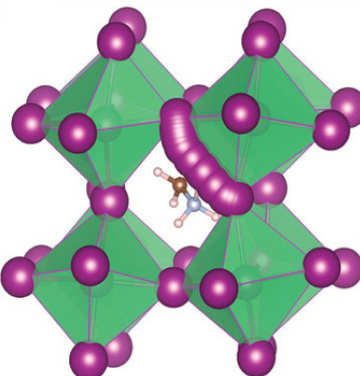
Could the migration of iodide vacancies explain hysteresis in perovskite solar cells? Our recent study in published Nature Communications suggests they could be.
We've determined the optical constants of single crystals of the three main hybrid perovsktie species (CH3NH3PbI3, CH3NH3PbBr3 and CH3NH3PbCl3) using spectroscopic ellispometry. The absorption features are assigned to electronic transitions between the bands using the highest level of ab inito calculation and we've also unpicked composition of transient absorption measurements on these materials. Aurelien and Pooya's (at KCL) work is published in Nanoscale. The optical constants are tabulated in the supporting information which will hopefully prove a useful resource.
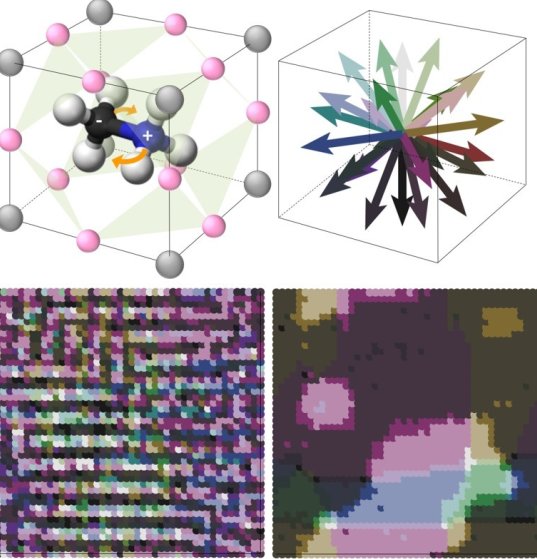
Paper about small things moving around in small cages just published. Methylammonium lead halide is like a prison for charged organic molecules - they are trapped within an oppressive and negative inorganic crystal structure! By tormenting these molecules with a beam of neutrons we've been able to see them wriggling. Why? It might help us to better understand the interesting behaviour seen in solar cells made with these perovskite materials. Find out more in Nature Communications.

Aurelien's paper published in Chemistry of Materials in collaboration with and Yinghong Hu from Pablo Docampo's group in Munich. It shows that exposing CH3NH3PbI3 perovskite (MAPI) to water vapour results in the reversible formation of first a monohydrated structure, CH3NH3PbI3.H2O, followed by a dihydrate structure (CH3NH3)4PbI6.2H2O. The hydrates can be converted back to MAPI on drying. Drying also allowed the performance of photovoltaic cells to be recovered after exposure to water. This represents an important step in our understanding of the degradation pathway's of perovskite solar cells. In the supporting information of the paper we tabulate what we believe are the first optical constants (refractive index and extinction coefficients) determined from ellipsometry of both single crystals of CH3NH3PbI3 and CH3NH3PbI3.H2O.
The weird and wonderful transient optoelectronic behaviour of perovskite solar cells is illuminated in our recent J. Am. Chem. Soc. paper. This shows that optical perturbations induce a movement of chemical charge in addition to generating free electrons and holes.
Fabian, Jarvist and Valerie's article on the effect of nearby substrates on the reorganization energy for intermolecular charge transfer is now published in Phys. Chem. Chem. Phys. They have developed a (relatively simple - see diagram above) method to estimate the contribution of different dielectric media surrounding a molecule to its polarization energy and outer sphere reorganization energy.
 Valerie's new paper out in Chemistry of Materials. She calculates that if molecules attached to surfaces can flap about they can transport charges faster than if they are staticly fixed. Molecular flapping may expain why simulations of fixed distributions of molecules do not predict as fast charge transport as is observed experimentally.
Valerie's new paper out in Chemistry of Materials. She calculates that if molecules attached to surfaces can flap about they can transport charges faster than if they are staticly fixed. Molecular flapping may expain why simulations of fixed distributions of molecules do not predict as fast charge transport as is observed experimentally.
Advanced Materials paper table of contents graphic comparing the stability of different solar technologies at high light intensity features on TOCROFL!
Davide's hole hopping paper (described below) has been covered in a short article published in Chemistry World.
His work entitled "The reorganization energy of intermolecular hole hopping between dyes anchored to surfaces" has just been published in Chemical Science. The reorganisation energy (λ) is often a critical parameter for calculating the rates of charge transfer between molecules, however there are surprisingly few experimental values available in the literature, and none for self-exchange reactions on surfaces. This work uses cyclic voltametry to measure the diffusion coefficient (Dapp) of holes jumping between molecules attached to mesoporous TiO2 films. Estimates of the reorganisation energy for charge transfer between these sensitiser molecules are derived from the variation of the diffusion coefficient with temperature. The technique is simple and the results show pretty good agreement with Valerie's calculations (described in more detail in her article below). The transport of charge along surfaces by "molecular wiring" has many interesting potential applications in solar cells and beyond.
Valerie's paper published: ''Influence of polar medium on the reorganization energy of charge transfer between dyes in a dye sensitzed film''. Her article presents a useful and accessible method for adapting standard quantum chemical calculation techniques to account for the solvent reorganisation energy during charge transfer between molecules. Her calculations show that medium surrounding molecules has a much bigger effect on charge transfer than is often assumed.
Review of transient measurements of dye sensitised solar cells is finally published: ''Interpretation of Optoelectronic Transient and Charge Extraction Measurements in Dye-Sensitized Solar Cells''. This should cover almost everything you might want to know (and plenty you probably don''t) about measuring electron transport and recombination kinetics in this class of devices! You might note that the study is a little longer than a typical Advanced Materials letter...

Background
My undergraduate studies were at the University of Bristol (MSci Physics, 1998), following this I joined the British Antarctic Survey in Cambridge (1998-2003). There, my PhD work established the typical distribution of impurities in polycrystalline polar ice and its consequences for electrical profiling measurements of ice cores and the post-depositional change of chemical strata in ice sheets. I spent two field seasons in Antarctica as part of a team drilling and measuring the Dome C ice core followed by developing methods to measure the paleoroughness of ice sheets hosted by the University of New South Wales in Australia (2003).
A postdoctoral fellowship with the CSIRO in Australia (2004-2007) with Dr Ian Plumb enabled me to investigate photoelectrochemical water splitting for solar hydrogen production. My activities involved the fabrication, measurement and simulation of metal oxide photoelectrodes, focused on TiO2, ZnO, WO3 and Fe2O3 and the accurate measurement of efficiency.
In 2007 I moved to Imperial College to study efficiency loss mechanisms in dye sensitised solar cells with Dr Brian O’Regan and Prof. James Durrant. In 2011 I was awarded an EPSRC Career Acceleration Fellowship allowing me to start a group to explore the theme of “Charge Carrier Dynamics and Molecular Wiring in Hybrid Optoelectronic Devices”. We now work closely with Prof. Jenny Nelson and many other groups around the College and beyond.
Publications
Journals
Salter LCB, Wojciechowski JP, McLean B, et al., 2024, 3,4-Ethylenedioxythiophene Hydrogels: Relating Structure and Charge Transport in Supramolecular Gels, Chemistry of Materials, ISSN:0897-4756
Calado P, Barnes PRF, 2021, Ionic screening in perovskite p-n homojunctions, Nature Energy, Vol:6, ISSN:2058-7546, Pages:589-591
Moia D, Abe M, Wagner P, et al., 2020, The effect of the dielectric environment on electron transfer reactions at the interfaces of molecular sensitized semiconductors in electrolytes, The Journal of Physical Chemistry C: Energy Conversion and Storage, Optical and Electronic Devices, Interfaces, Nanomaterials, and Hard Matter, Vol:124, ISSN:1932-7447, Pages:6979-6992
Moia D, Gelmetti I, Calado P, et al., 2019, Ionic-to-electronic current amplification in hybrid perovskite solar cells: ionically gated transistor-interface circuit model explains hysteresis and impedance of mixed conducting devices, Energy and Environmental Science, Vol:12, ISSN:1754-5692, Pages:1296-1308





